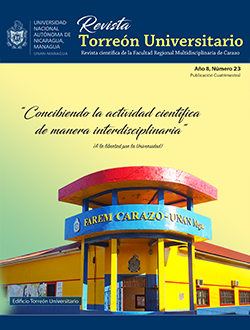Identificación y cuantificación de residuos de plaguicidas en hortalizas de alto consumo comercializadas en mercados y supermercados de Managua
DOI:
https://doi.org/10.5377/torreon.v8i23.9532Palabras clave:
codex alimentarius, límites máximos de residuos, matrices vegetales, plaguicidasResumen
El uso de plaguicidas para el control de plagas es una práctica común en los sistemas de producción agrícola de Nicaragua. En este estudio se determinaron las concentraciones de 21 plaguicidas (7 insecticidas organofosforados, 1 insecticida organoclorados, 3 insecticidas piretroides, 7 herbicidas y 3 fungicidas) en muestras de tomates, chiltoma, lechuga y repollo colectadas en 2 mercados populares y 2 supermercados de Managua. El análisis de las muestras refleja que el 55,0% de estas contienen plaguicidas, lográndose identificar residuos de clorpirifos, mocap, cipermetrina, clorotalonil, imazalil, diazinon, deltametrina, simazina y 2,4-D, en concentraciones entre 0,005 mg/kg hasta 5,3 mg/kg. El 20,0 % de las muestras contienen concentraciones de residuos que sobrepasan los valores establecidos en el Codex Alimentarius en las matrices lechuga (diazinon), repollo (clorpirifos y diazinon), Tomate (mocap y deltametrina).
Descargas
Descargas
Publicado
Número
Sección
Licencia
The authors who publish in this journal agree to the following terms.
- The author or authors of the articles, essays or research grant the National Autonomous University of Nicaragua, Managua (UNAN-Managua) the editing rights (copyright) of the submitted work, therefore the University has the exclusive right to publish the article for the entire copyright period.
- These copyrights/authors authorize Torreón Universitario Magazine and the University to edit and disseminate/publish the article in said Magazine, including printed and electronic reproduction, storage, retrieval and any other type of publication, and sources of secondary information as services. of summaries and databases, they also empower it to protect the article against unauthorized use for dissemination by printed or electronic media (PDF, HTML, EPUB, XML or others).
License for use of content
The magazine uses the Creative Commons Attribution-NonCommercial-NoDerivs 4.0 International License.
Under this statement:

This journal is licensed under a Creative Commons Attribution-NonCommercial-NoDerivatives 4.0 International License. It can be copied, distributed and transmitted publicly as long as the author and source are cited (Revista Torreón Universitario), it should not be modified or used for any commercial purpose. The full license can be found at http://creativecommons.org/licenses/by-nc-nd/4.0/.



